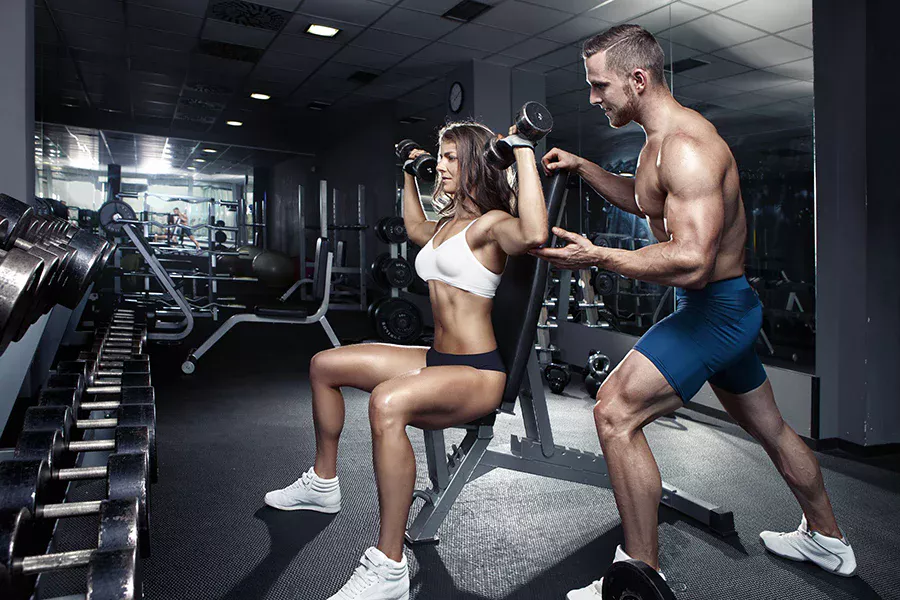Have you finally decided to get your body in order, but don’t know where to start? Feel free to join our four-week program that will teach you step by step what and how to do to become strong, lean and muscular.
Surely each of us has promised ourselves more than once: “That’s it! Iron! Starting next week I’m going on a diet and going to the gym!” Monday comes, and immediately there are thousands of excuses to postpone going to the gym for another week or two… But if you picked up our magazine, you are already close to keeping your promise. Believe me, you have already taken the first and, most importantly, the right step on this path.
MUSCLE & FITNESS, in a team with the international association of science and sports ISSA (International Sports Skins Assosiasion), have created a basic “inclusion in fitness” program that will improve your health, give you a great body shape and, finally, give you a hobby that will surely “hook” you on all life. Regardless of who you are – a complete “teapot” or a well-deserved “veteran” who has returned to iron sport after a long break, our program is an ideal initiation (or return) to the world of strength and beauty.
So, get ready! In the next 28 days, you will have to mercilessly “load iron” on all your muscles literally from head to toe, desperately pedaling an exercise bike or treadmill. Don’t be lazy, follow our recommendations exactly and soon you will be surprised at how much your figure has changed.
WEEK 1
Work out the first week of the program according to a two-day split “upper/lower body” in 3-day cycles with an additional day off on Sunday: on the first day you train the muscles of the lower body, on the second – the upper body, on the third – rest. This “division” of muscles in half (into the upper and lower parts of the body) will help you quickly get into the rhythm of strength training and at the same time prevent muscle overtraining. In addition, our workouts will hardly disrupt your usual daily routine, since they take no more than an hour.
Each exercise is performed for 8-12 repetitions with a break between sets of 90-120 seconds. You may feel like you can do more reps or sets – don’t rush! “In the first week, the nervous system gets used to the stress, and even if you don’t have sore throat, very important processes still take place inside the body. The main thing during this period is to concentrate on the technique of performing the exercise, and not try to lift as much weight as possible,” explains Patrick Gemboa, director of the technical and educational department of ISSA.
Finish each strength workout this week with 20 minutes of cardio on a stationary bike, treadmill, or other cardio machine. Your heart rate should be between 60-70% of your maximum heart rate (see cardio tips). For beginners, Gemboa advises pedaling an exercise bike, while experienced fighters can choose the cardio equipment of their choice. “Always do cardio after strength training. This is great for fighting fat deposits,” recommends Gemboa.
WEEK 2
By the beginning of this week, you’ve already gotten into a rut, and it’s time to pick up the pace. Still continue training in a two-day split, but reduce the time between sets. As for the working weight, it can be left the same, the main thing is that muscle failure occurs between 8 and 12 repetitions. If you feel that you are able to do more than 12 repetitions, increase the weight, and vice versa, if you cannot do 8 repetitions, then reduce the weight.
WEEK 3
Now that you have already mastered the exercise technique and feel like a fish in water in the gym, you can properly “tighten the screws.” Therefore, we switch to a new, more intense training regimen – a three-day split. We “divide” the body no longer in half, but into three parts: workout 1 – chest and back: workout 2 – legs; workout 3 – shoulders, biceps, triceps and abs. The idea of this division is simple – at every workout we work out the antagonist muscles. For example, chest and back: when we contract the muscles of the chest, the muscles of the chest stretch and vice versa. This technique allows you to go through each muscle involved quite thoroughly and “deeply”. We will work out our three-day split in a cycle of 5 days: two days of training, a day of rest, training again and rest again. In this mode, the muscles have been resting for four whole days, so you can safely increase the load. Now in each exercise we will perform not two, but 3-4 sets. In addition, increase the working weight by 5-10% every week, but not at the expense of technique. We also recommend increasing the cardio intensity and practicing a traditional 20-minute session at a heart rate of 70-80% of MRP.
WEEK 4
We are reaching the finish line. We continue to work according to the three-day slit, but we’ll add a little fuel to the fire – we’ll combine exercises for different muscle groups in pairs and perform them in supersets. For example, after working out a set of dumbbell bench presses (chest), we do not rest, but immediately perform a set of horizontal rows (back). This is one superset. Rest between supersets is 90 seconds. Keep in mind that supersets not only increase the intensity of your workout, but also allow you to significantly reduce it, which is extremely important if you are short on free time. In addition, supersets perfectly stimulate the heart muscle and, compared to regular sets, burn much more calories and “dry” the muscles quite effectively.
Two week split
Weeks 1 and 2
Day 1 and 4: lower body, abs, lower back, cardio
Day 2 and 5: upper body, cardio
Day 3, 6 and 7: rest
Weeks 3 and 4
Day 1: chest, back, abs, lower back , cardio
Day 2: legs, cardio
Day 4: shoulders, triceps, biceps, abs, cardio
Day 3 and 5: rest
WORKOUT
Week 1: For each exercise, perform 2 sets of 8-12 reps, resting 90 seconds between sets.
Week 2: Work the exercises as before in 2 sets of 8-12 reps, but reduce the time between sets to one minute.
Lower Body Workout
Quadriceps: Hack Squats, Seated Leg Extensions
Hamstrings: Stiff Leg Deadlifts, Lying Leg
Curls Calves: Standing Calf Raises Lower
Back: Hyperextension
Abs: Crunches, Hip Thrust
Upper Body Workout Chest
Dumbbell Press lying down, Peck-Deck information
Back: Wide-grip vertical row, horizontal row
Shoulders/traps: Seated dumbbell press, dumbbell shrugs
Triceps: Press down
Biceps: Dumbbell transverse curls
Workout
Week 3: Perform 3-4 per exercise sets of 6-10 repetitions. Rest between sets is no more than 90 seconds.
Day 1
Chest: Dumbbell bench press, Peck-Deck training
Back: Wide grip vertical row, horizontal row
Lower back: Hyperextension
Abs: Crunches
Day 2
Quadriceps: Hack squats, seated leg extensions
Hamstrings: Stiff-legged deadlifts, lying leg curls
Calfs: Standing calf raises
Day 4
Shoulders/traps: Seated dumbbell press, dumbbell shrugs
Triceps: Squat press
Biceps: Alternating raises Dumbbell Biceps
Abs: Crunches, Hip Thrust
Week 4: Group exercises and superset them
Day 1
Dumbbell bench press + wide-grip upright row; horizontal row + information in the Peck-Deck simulator; hyperextension + crunches
Day 2
Hack squats + stiff legged deadlifts; leg curls + seated leg extensions; standing calf raises (performed with a regular set)
Day 4
Seated dumbbell press + dumbbell shrugs; alternating dumbbell biceps curls + downward press; Crunches + Hip Thruat
Work each pair of exercises with 3-4 supersets of 8-12 reps per exercise. Rest between supersets – 90 seconds.
Hack Squats
» Stand in the hack machine. Rest your shoulders against the upper bolsters and place your feet shoulder-width apart on the platform. Remove the weight from the supports and smoothly lower down to the platform. Once the angle between your thigh and shin is straight, press your heels firmly into the platform, tighten your quadriceps, and push yourself up. At the top point, the legs are straightened at the knees, but not completely.
Seated Leg Extensions
» Adjust the assist roller on the machine so that it is just above the instep of your foot. Tighten your quadriceps and straighten your knees completely. Pause for a second and then slowly lower the weight.
Lying leg curls
» Lie on your stomach so that the rollers are directly above your ankle. Tighten the muscles at the back of your thighs and, bending your knees, pull your feet towards your buttocks. As soon as the roller touches your buttocks, pause and tighten your glutes and hamstrings even more. Then smoothly straighten your legs and lower the weight to the starting position.
Standing calf raises
» Stand with your toes on the step, your heels elevated. Without bending your knees, lower yourself down until you feel that the muscles of your lower legs are properly stretched. Tighten your calves and rise up on your toes as high as possible. Pause, tighten your calves even more, and slowly lower yourself down.
Stiff-legged deadlift
» Grasp the barbell with an overhand grip, slightly wider than shoulder-width apart, with your palms on either side of your hips. Stand up straight. Feet shoulder-width apart and slightly bent at the knees. The back is straight. Lean forward while maintaining the natural arch of your spine. At the same time, the buttocks move backward. Remember to keep your back straight and your legs slightly bent. Having lowered your torso until it is parallel to the floor, tighten your buttocks and slowly straighten up, returning to the starting position.
Crunches
» Lie on your back and bend your knees. Feet pressed firmly to the floor. Place your hands behind your head, but do not clasp them; your chin is pointing upward. Inhale and hold your breath. Tighten your abs and, rounding your back, twist towards your knees – lift your head and shoulders up and forward. Your task: to make the distance between the chest and pelvis minimal. Exhale and slowly unwind to the starting position. Perform the exercise smoothly, without jerking.
Hyperextension
» Lie on your stomach on a Roman chair. Place your hands behind your head or cross them over your chest and slowly lower yourself down until your torso is perpendicular to your butt. Tighten your lumbar muscles and smoothly rise up. At the top point, the torso should be slightly above parallel with the floor.
Hip Thrust
» Lie on the floor and lift your legs straight up. Stretch your arms along your body. Without lifting your head, shoulders and shoulder blades from the floor, tense your abs and smoothly, without jerking, “push” your pelvis up. Try to raise your pelvis 5-10 cm from the floor. Tighten your abs even more and slowly lower your pelvis and hips to the starting position.
Peck-Deck Equipment
» Adjust the information so that when you grasp the handles of the machine, your upper arms (elbow to shoulder) are parallel to the floor. Tighten your chest and bring your handles together in front of you. Pause and tighten your pectoral muscles even more. Slowly open your arms. Don’t let the weight rest on the supports and don’t relax your chest until the end of the set.
Dumbbell Bench Press
» Hold dumbbells in both hands and lie down on a flat bench. Hold dumbbells at the sides of your shoulders. Palms face forward, angle at elbows is straight. Tighten your chest and powerfully press the dumbbells in an upward arc so that they lightly “click” just above the middle of your chest. At the top point, the arms are straightened at the elbows, but not completely (not locked at the elbow joint). Smoothly lower the dumbbells to your shoulders.
Horizontal row
» Sit on a seat facing a rack with a weight. Legs slightly bent at the knees, chest and shoulders straightened. The cable is taut and the arms are straight. Tighten your lats and gently pull the handle towards your stomach. Elbows “slide” along the sides. Don’t fall back. Once the handle is near your stomach, pause and tighten your lats even more. Pull and release the handle smoothly, without jerking.
Seated Dumbbell Press
» Take a pair of dumbbells and sit on a bench with the back upright. Place your feet on the floor. In the starting position, the dumbbells are located on the sides and just above the shoulders (and not strictly above them!). Palms facing forward. Press the dumbbells up overhead. At the top point, the elbows are slightly bent and the dumbbells almost touch each other. In a reverse motion, smoothly lower the dumbbells until the angle at your elbows becomes 90 degrees.
Alternating dumbbell curls
» Stand straight. Hands with dumbbells at your sides, palms facing forward. Tighten the biceps of your left arm and, keeping your shoulders and torso stationary, lift the dumbbell directly to your shoulder. Using the same trajectory, return the dumbbell to the starting position and perform a biceps curl with your right hand. This is one repetition.
Shrugs with dumbbells
» Stand straight, arms with dumbbells at your sides, palms facing your hips. The arms are slightly bent. Tighten your trapezius and pull your shoulders straight up towards your ears, as if you want to say “I don’t know.” Pause, then slowly lower your shoulders straight down.
Down Press
» Attach a straight or V-shaped handle to the top cable. Grab it with an overhand grip (palms facing down) and pull it up to chest level. The arms are bent at the elbows at a right angle and pressed tightly to the sides. Tighten your triceps and, extending your arms, press the handle down toward your hips. Pause and smoothly return the handle to its original position. Don’t relax your triceps or let the handle fly up on its own.
Wide Grip Vertical Row
» Grab the handle with a wide grip. Palms face forward. Bend well at the lower back, move your shoulders back and down, straighten your chest. Maintain this body position throughout the entire set. Tighten your lats and, squeezing your shoulder blades, pull the handle toward your chest. As soon as the handle is at your chest, tighten your lats even more and smoothly return to the starting position. Throughout the entire set, do not relax your muscles and do not allow the weight to touch the supports.
IRON RULES
» Be sure to warm up your muscles and joints for 5-10 minutes before strength training. This will speed up blood circulation and protect yourself from possible injuries.
» After your workout, take 5-15 minutes to stretch, holding each muscle in a stretched position for 30-60 seconds. This will allow you to significantly increase the range of motion in strength exercises in the next lesson. In addition, stretching exercises reduce soreness and prevent injuries.
» Do not load your muscles for three days in a row! At a minimum, every third day should be a “day off”, without strength training, otherwise the muscles will not have time to fully recover by the next session.
» Perform all strength exercises smoothly, controlling the weight at each point of the movement. Avoid sudden movements, jerks and jolts.
» If you suddenly feel a sharp pain while exercising, stop immediately. You’re probably doing the exercise incorrectly. If the pain does not subside, refrain from this exercise in the future. It may not be suitable for you personally. Consult with your trainer what other exercises you can replace it with.
» Drink water before, during and after exercise, at least one glass every 20 minutes during exercise and even more if you sweat a lot.
» Mild muscle soreness after training is normal. But if the pain does not subside within a few days, be sure to consult a doctor.
“ After completing our 4-week course, do not stop, but boldly move forward. Getting in shape is just the beginning. Next, it needs to be supported and improved. No matter how successful our program is, repeating it is taking a step back. Be sure to change your future workouts – include other exercises, add more sets and new techniques.
CARDIO TIPS
In pursuit of larger chest or back muscles, never forget about the most important muscle – the heart! Our tips will help you conduct a cardio session effectively and beneficially for your heart.
» Do 20 minutes of cardio 4-5 times a week. If you are overweight, the duration of cardio can be increased.
» Change cardio equipment and session tempo more often. The body quickly gets used to the same loads and, as a result, spends less energy doing the same work. Consequently, the effectiveness of such training is reduced.
» During a cardio session, constantly monitor your heart rate using the cardio machine scale. During the first and second weeks, the heart rate should be within 60-70% of the MRP; in the third and fourth weeks – 70-80% of the MDP.
»If you suddenly feel unwell during a cardio workout (nausea, dizziness, rapid heartbeat), stop, sit down, drink water and rest. If these sensations do not go away, consult a doctor.
WE CALCULATE YOUR Maximum Allowable Heart Rate (MAP)
Maximum Allowable Heart Rate = 220 minus age. The recommended heart rate is measured as a percentage of MRP. Example: Calculation of the recommended heart rate during cardio (60-70% of MRP) for a man 30 years old 220 – 30 = 190* MRP
190 x 60% = 114
190 x 70% = 133
So, recommended heart rate = from 114 to 133 beats in a minute.
THE WAY YOU EAT IS THE WAY YOU LOOK
Eat as often as possible. Calculate the total number of calories you eat per day and distribute them evenly over 4-6 meals. Eating frequently speeds up your metabolism and constantly supplies the body with the nutrients it needs for repair and growth.
» Protein foods should be present in every meal. Protein satisfies hunger for a long time and at the same time helps to grow muscles. A large amount of protein is found in veal, chicken breast, turkey, egg whites, salmon, and low-fat cottage cheese. Daily Value: 2 grams of protein for every kilogram of your body weight.
» Complex carbohydrates supply the body with energy and are critical for all vital processes. Therefore, be sure to include whole grains, unprocessed foods in your menu, such as oatmeal, brown rice, and potatoes. In addition, it is advisable to exclude white bread, pasta and sugar from the diet. This type of carbohydrate tends to turn into fat.
» Load up on fruits and vegetables. They participate in the process of digesting food, supply vitamins, minerals and photocells necessary for high-quality muscle building.
» Not all fats are harmful. Paradoxically, unsaturated fats even help dry out muscles. They transport fat-soluble vitamins, provide a continuous supply of energy and produce hormones. Sources of healthy, unsaturated fats include olive, flaxseed and nut oils, avocado and fish. Avoid heavy, saturated animal fats, mayonnaise and foods cooked in fat.
» Control portion sizes. Each meal should contain: 1) a palm-sized piece of meat or fish, 2) complex carbohydrates the size of an orange, 3) fats (oil) – no more than one teaspoon. Of course, these are only approximate volumes of products. The exact portion size is directly determined by your constitution. For example, if you find it difficult to gain muscle mass, portion sizes can be increased.







